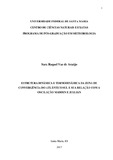| dc.creator | Araujo, Sara Raquel Vaz de | |
| dc.date.accessioned | 2018-07-16T20:09:41Z | |
| dc.date.available | 2018-07-16T20:09:41Z | |
| dc.date.issued | 2017-06-14 | |
| dc.identifier.uri | http://repositorio.ufsm.br/handle/1/13803 | |
| dc.description.abstract | In the southern summer period over South America, an important system is one of the main modulators of the rainfall regime of the working regions, the SACZ. This system is a nebulosity zone that extends from the Amazon region and it comprehends the midwest and southeast regions, extending it to the southwest of the South Atlantic Ocean. This system will lead to large volumes of rainfall, which can sometimes bring disorders to society, such as landslides, floods, etc. In addition, from the point of view of the predictability of this phenomenon, it has been created an interest in understanding how to adequately represent it in numerical models. One of the most important reasons for this is that in the current context, the global models still can not satisfactorily represent this zone of convergence. Therefore, the purpose of this study was to analyse how the regional model RegCM4 will represent the different atmospheric characteristics when SACZ occurs, due to the importance of the convergence zone thanks to its effects on the regions where the band is stationed. For this, 10 events of SACZ were selected, according to the active phases of the Madden and Jullian Oscillation, being this oscillation important for the tropical convection and in the occurrence of SACZ. After this selection, the average fields of the events of each variable were evaluated, which were: precipitation, surface wind in 850 and 250 hPa, geopotential height in 250 hPa, omega, air temperature, equivalent potential temperature, vorticity, divergence and specific humidity. Finally, the simulations of the RegCM4 model were generally satisfactory for most of the variables, with some displacements regarding the position of some systems that contribute to the formation and maintenance of the SACZ. | eng |
| dc.description.sponsorship | Coordenação de Aperfeiçoamento de Pessoal de Nível Superior - CAPES | por |
| dc.language | por | por |
| dc.publisher | Universidade Federal de Santa Maria | por |
| dc.rights | Attribution-NonCommercial-NoDerivatives 4.0 International | * |
| dc.rights.uri | http://creativecommons.org/licenses/by-nc-nd/4.0/ | * |
| dc.subject | ZCAS | por |
| dc.subject | Modelo regional | por |
| dc.subject | OMJ | por |
| dc.subject | SACZ | eng |
| dc.subject | Regional model | eng |
| dc.subject | MJO | eng |
| dc.title | Estrutura dinâmica e termodinâmica da zona de convergência do Atlântico Sul e sua relação com a oscilação Madden e Jullian | por |
| dc.title.alternative | Dynamic and thermodynamic structure of the South Atlantic convergence zone and yours relationship with Madden and Jullian oscillation | eng |
| dc.type | Dissertação | por |
| dc.description.resumo | No período do verão austral sobre a América do Sul, um importante sistema é um dos principais moduladores do regime de chuvas das regiões atuantes, a ZCAS, que é uma zona de nebulosidade que se estende desde a região amazônica, compreendendo as regiões centro oeste, as regiões sudeste, e estendendo-se até o sudoeste do Oceano Atlântico Sul. Este sistema irá acarretar grandes volumes chuvas, o que por vezes pode trazer transtornos para a sociedade, como deslizamentos, alagamentos, etc. Do ponto de vista da previsibilidade deste fenômeno, tem se criado interesse em compreender como representa-lo adequadamente em modelos numéricos; pois no contexto atual, os modelos globais ainda não conseguem representar de forma satisfatória esta zona de convergência. Logo devido a importância da zona de convergência por conta dos seus efeitos, sobre as regiões em que a banda estaciona, a proposta deste trabalho foi analisar de que forma o modelo regional RegCM4, irá representar as diferentes características atmosféricas quando há a ocorrência de ZCAS. Para isso foram selecionados 10 eventos de ZCAS, conforme as fases ativas da Oscilação de Madden e Jullian, sendo esta oscilação importante para a convecção tropical e na ocorrência de ZCAS. Após a seleção dos eventos, foram avaliados os campos médios dos eventos de cada uma das variáveis como: Precipitação, vento em superfície, 850 e 250 hPa, altura Geopotencial em 250hPa, ômega, Temperatura do ar, Temperatura Potencial Equivalente, Vorticidade, Divergência e Umidade Específica. Os eventos foram divididos em três grupos (quanto a distribuição da chuva) para as análises. As simulações do modelo RegCM4, de forma geral foram satisfatórias para a maioria das variáveis, havendo alguns deslocamentos quanto a posição de alguns sistemas que contribuem para formação e manutenção da ZCAS. | por |
| dc.contributor.advisor1 | Ferraz, Simone Erotildes Teleginski | |
| dc.contributor.advisor1Lattes | http://lattes.cnpq.br/5545006407615789 | por |
| dc.contributor.referee1 | Boiaski, Nathalie Tissot | |
| dc.contributor.referee1Lattes | http://lattes.cnpq.br/8599135403486788 | por |
| dc.contributor.referee2 | Quadro, Mario Francisco Leal de | |
| dc.contributor.referee2Lattes | http://lattes.cnpq.br/4111514204790887 | por |
| dc.creator.Lattes | http://lattes.cnpq.br/7668156846851881 | por |
| dc.publisher.country | Brasil | por |
| dc.publisher.department | Meteorologia | por |
| dc.publisher.initials | UFSM | por |
| dc.publisher.program | Programa de Pós-Graduação em Meteorologia | por |
| dc.subject.cnpq | CNPQ::CIENCIAS EXATAS E DA TERRA::GEOCIENCIAS::METEOROLOGIA | por |
| dc.publisher.unidade | Centro de Ciências Naturais e Exatas | por |



